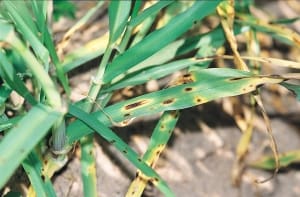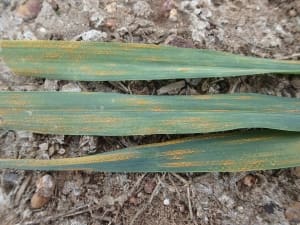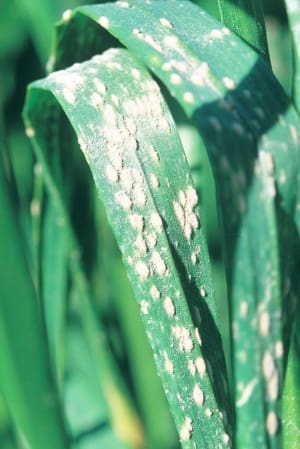A LONG-AWAITED seasonal turnaround continues to deliver many New South Wales growers one of the better winter cropping season in years with medium to high yield potential in cereal crops.
It’s also placed them on high alert for the development of cereal fungal diseases such as spot form net blotch, scald, powdery mildew and rust as they strive to maximise crop yield and gross margins.

Steven Simpfendorfer
A real challenge for growers and their agronomists lies in correctly identifying whether leaf yellowing or discolouration is related to disease, frost, herbicide phytotoxicity, physiological stress responses or agronomic constraints such as nitrogen (N) deficiency.
Incorrect identification can lead to unnecessary expenditure on fungicide applications which won’t necessarily address the underlying issue according to New South Wales Department of Primary Industries (NSW DPI) senior plant pathologist Steven Simpfendorfer.
“Our advice is, don’t jump at shadows. We’re in a very wet year but that doesn’t mean that every issue in cereal crops is caused by disease,” Dr Simpfendorfer said.
“Fungicides won’t fix herbicide or frost damage and they won’t correct nutrient deficiencies.”
Get the diagnosis right
Physiological spotting that is not disease-related occurs every year, particularly in barley crops, and 2020 is proving no exception.
However, disease has clear patterns of distribution within paddocks, plants and even on individual leaves.

Dr Simpfendorfer said diseases like spot form net blotch had clear patterns of distribution, but accurate identification could still be challenging.
Despite this, Dr Simpfendorfer said accurate identification could be difficult and encouraged growers to seek a second opinion from a plant pathologist before embarking on a fungicide application.
“I was always taught to walk into a paddock and assume that the symptoms were not caused by disease. There are a lot of boxes to tick before you can convincingly attribute disease as the cause,” he said.
“Earlier in the season there were a number of reports of leaf spotting which were actually due to contact herbicide, drift or inversion rather than disease.
“Similarly, we are starting to see some underlying nutrient issues, particularly in areas where N mineralisation hasn’t been as high as hoped, which are expressing as mottling from the leaf tip backwards. Fungal diseases do not concentrate toward leaf tips.
“If growers are unsure, help is available simply by texting or emailing some good quality photos and relevant details such as variety and paddock history to NSW DPI pathologists in Tamworth. This can be a quick way to rule disease in or out before pulling the sprayer out of the shed.
“If symptoms appear consistent with disease, we can then confirm this through testing of submitted samples.”
Submitted photos should be high quality and include images of:
- the affected paddock (showing the distribution of symptoms)
- affected individual plants (showing the distribution of symptoms through the plant canopy)
- affected individual leaves (showing the symptoms you are concerned about).
These can be sent to Dr Simpfendorfer on 0439 581 672, [email protected] or via Twitter to @s_simpfendorfer or @NSWDPI_AGRONOMY
Diseases have a latent period
All diseases have a `latent period’ which refers to the number of days from when the fungal pathogen infects the plant leaf to when symptoms such as lesions or pustules become visible on leaves. The latent period varies in length depending on the disease and temperature.

Dr Simpfendorfer advises growers to give careful consideration to fungicide application and keep in mind that disease, such as stripe rust (pictured) has a 10-14 day latent period so pustules that are now being observed on leaves started from infection events around a fortnight ago.
Therefore, symptoms expressed in a crop will be related to infection events that occurred days or weeks previously.
Stripe rust for example, has a 10-14 day latent period so pustules that are now being observed on leaves started from infection events around a fortnight ago.
“Give careful consideration to any fungicide application – panicked decisions are not always the best decisions,” Dr Simpfendorfer said.
“It’s well worth taking the time to ensure you have the correct diagnosis which can be as simple as texting photos.
“Using up tight fungicide stocks on physiological, nutritional, environmental or herbicide related symptoms wastes product and may leave growers short during spring when a timely fungicide application may have maximum economic benefit.”
If it’s disease, timing is everything
All fungicides have stronger preventative than curative activity against leaf diseases. This means that they are generally most effective when applied prior to or early in disease development rather than once the disease has established in a crop.
Once lesions or pustules have developed on infected leaves and green leaf area has been lost, it cannot be restored by application of a foliar fungicide.
Fungicide management strategies in cereal crops are all about maintaining green leaf area on the top three leaves, as these are the main contributors to yield.

Dr Simpfendorfer said fungicide decisions were an economic decision. They didn’t increase yield, they protected yield. (Pictured: powdery mildew on wheat).
Strategies should be tailored to disease risk within a crop, varietal resistance to these diseases, growth stage, disease levels, yield potential and weather conditions in the previous two weeks and next two to four weeks. Hence, these decisions can be quite complicated.
“Fungicides are an economic decision. They don’t increase yield, they protect yield potential,” Dr Simpfendorfer said.
“Not all varieties will need extra protection from in-crop fungicide application if they have an adequate level of resistance to the disease of interest.
“On the flipside, susceptible varieties are likely to require protection if under disease pressure and weather conditions conducive to disease development are expected.”
To help avoid any surprises, growers should ensure they are up-to-date with the latest variety ratings for sown varieties as published in the Winter Crop Variety Sowing Guide 2020.
Variety ratings are updated annually to reflect the expected reactions to any new pathotypes of different pathogens.
“Be aware that some things have invariably changed since the last time widespread infections of leaf diseases occurred,” Dr Simpfendorfer said.
“Do not assume that the resistance levels in your wheat varieties are the same as three years ago, as new pathotypes of rust pathogens have developed and are potentially distributed widely across NSW.
“Make sure you are using the latest resistance ratings and manage crops appropriately based on this.”
Source: GRDC
Useful resources:
GRDC Update paper Cereal disease management in 2020 – from famine to moving feast
GRDC Grains Research Update webinar – Diseases
Grain Central: Get our free daily cropping news straight to your inbox – Click here

HAVE YOUR SAY